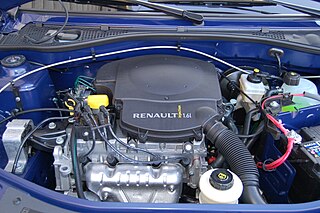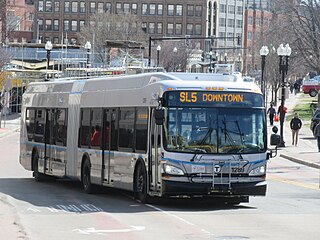Related Research Articles

An electric boat is a powered watercraft driven by electric motors, which are powered by either on-board battery packs, solar panels or generators.

A hybrid vehicle is one that uses two or more distinct types of power, such as submarines that use diesel when surfaced and batteries when submerged. Other means to store energy include pressurized fluid in hydraulic hybrids.

An electric vehicle (EV) is a vehicle that uses one or more electric motors for propulsion. It can be powered by a collector system, with electricity from extravehicular sources, or it can be powered autonomously by a battery. EVs include but are not limited to road and rail vehicles, and broadly can also include electric boat and underwater vessels, electric aircraft and electric spacecraft.

In a motor vehicle, the powertrain comprises the main components that generate power and deliver that power to the road surface, water, or air. This includes the engine, transmission, drive shafts, differentials, and the final drive. Hybrid powertrains also include one or more electric traction motors that operate to drive the vehicle wheels. All-electric vehicles eliminate the engine altogether, relying solely on electric motors for propulsion. Occasionally the term powerplant is casually used to refer to the engine or, less often, the entire powertrain.
Hybrid Synergy Drive (HSD), also known as Toyota Hybrid System II, is the brand name of Toyota Motor Corporation for the hybrid car drive train technology used in vehicles with the Toyota and Lexus marques. First introduced on the Prius, the technology is an option on several other Toyota and Lexus vehicles and has been adapted for the electric drive system of the hydrogen-powered Mirai, and for a plug-in hybrid version of the Prius. Previously, Toyota also licensed its HSD technology to Nissan for use in its Nissan Altima Hybrid. Its parts supplier Aisin Seiki Co. offers similar hybrid transmissions to other car companies.

A solar vehicle or solar electric vehicle is an electric vehicle powered completely or significantly by direct solar energy. Usually, photovoltaic (PV) cells contained in solar panels convert the sun's energy directly into electric energy.

A plug-in hybrid electric vehicle (PHEV) is a type of hybrid electric vehicle equipped with a rechargeable battery pack that can be replenished by connecting a charging cable into an external electric power source, in addition to internally by its on-board internal combustion engine-powered generator. While PHEVs are predominantly passenger cars, there are also plug-in hybrid variants of sports cars, commercial vehicles, vans, utility trucks, buses, trains, motorcycles, mopeds, military vehicles and boats.

There are a wide variety of propulsion systems available or potentially available for automobiles and other vehicles. Options included internal combustion engines fueled by petrol, diesel, propane, or natural gas; hybrid vehicles, plug-in hybrids, fuel cell vehicles fueled by hydrogen and all electric cars. Fueled vehicles seem to have the advantage due to the limited range and high cost of batteries. Some options required construction of a network of fueling or charging stations. With no compelling advantage for any particular option, car makers pursued parallel development tracks using a variety of options. Reducing the weight of vehicles was one strategy being employed.
Mild hybrids (MHEV) are generally cars with an internal combustion engine (ICE) equipped with a negligibly bigger electric combined motor and generator in a parallel hybrid configuration allowing the engine to be turned off whenever the car is coasting, braking, or stopped, and then quickly restarted once power is again required. Mild hybrids may employ regenerative braking and some level of power assist to the internal combustion engine, but mild hybrids do not have an electric-only mode of propulsion.
Hybrid vehicle drivetrains transmit power to the driving wheels for hybrid vehicles. A hybrid vehicle has multiple forms of motive power.

A hybrid electric vehicle (HEV) is a type of hybrid vehicle that combines a conventional internal combustion engine (ICE) system with an electric propulsion system. The presence of the electric powertrain is intended to achieve either better fuel economy than a conventional vehicle or better performance. There is a variety of HEV types and the degree to which each function as an electric vehicle (EV) also varies. The most common form of HEV is the hybrid electric car, although hybrid electric trucks, buses, boats and aircraft also exist.

An alternative fuel vehicle is a motor vehicle that runs on alternative fuel rather than traditional petroleum fuels. The term also refers to any technology powering an engine that does not solely involve petroleum. Because of a combination of factors, such as environmental and health concerns including climate change and air pollution, high oil-prices and the potential for peak oil, development of cleaner alternative fuels and advanced power systems for vehicles has become a high priority for many governments and vehicle manufacturers around the world.
All-electric range (AER) is the maximum driving range of an electric vehicle using only power from its on-board battery pack to traverse a given driving cycle. In the case of a Battery electric vehicle (BEV), it means the maximum range per recharge, typically between 150 and 400 miles. For a plug-in hybrid electric vehicle (PHEV), it means the maximum range in charge-depleting mode, typically between 20 and 40 miles. PHEVs can travel considerably further in charge-sustaining mode which utilizes both fuel combustion and the on-board battery pack like a conventional hybrid electric vehicle (HEV).
Environmental impact-minimizing vehicle tuning is the modification of cars to reduce energy consumption.
Voltec, formerly known as E-Flex, is a General Motors powertrain released in November 2010. The Voltec architecture is primarily a plug-in capable, battery-dominant electric vehicle with additional fossil fuel powered series and parallel hybrid capabilities.

A battery electric vehicle (BEV), pure electric vehicle, only-electric vehicle, fully electric vehicle or all-electric vehicle is a type of electric vehicle (EV) that exclusively uses chemical energy stored in rechargeable battery packs, with no secondary source of propulsion. BEVs use electric motors and motor controllers instead of internal combustion engines (ICEs) for propulsion. They derive all power from battery packs and thus have no internal combustion engine, fuel cell, or fuel tank. BEVs include – but are not limited to – motorcycles, bicycles, scooters, skateboards, railcars, watercraft, forklifts, buses, trucks, and cars.

A range extender is a fuel-based auxiliary power unit (APU) that extends the range of a battery electric vehicle by driving an electric generator that charges the vehicle's battery. This arrangement is known as a series hybrid drivetrain. The most commonly used range extenders are internal combustion engines, but fuel-cells or other engine types can be used.

The Hyundai Blue-Will is a plug-in petrol-electric hybrid concept compact car designed by the South Korean car manufacturer Hyundai Motor Company. The vehicle was debuted at the 2009 Seoul Motor Show in South Korea.

A solar bus or solar-charged bus is a bus that is powered exclusively or mainly by solar energy. Solar-powered bus service is referred to as a solar bus service. The use of the term "solar bus" normally implies that solar energy is used not only for powering electric equipment on the bus, but also for the propulsion of the vehicle.

A drivetrain is the group of components that deliver mechanical power from the prime mover to the driven components. In automotive engineering, the drivetrain is the components of a motor vehicle that deliver power to the drive wheels. This excludes the engine or motor that generates the power. In marine applications, the drive shaft will drive a propeller, thruster, or waterjet rather than a drive axle, while the actual engine might be similar to an automotive engine. Other machinery, equipment and vehicles may also use a drivetrain to deliver power from the engine(s) to the driven components.
References
- ↑ "Electric vehicle definition and meaning | Collins English Dictionary". www.collinsdictionary.com. Retrieved 2019-03-27.
- ↑ "Definition of Electric Vehicles Description ElectricVehiclesNews.com". electricvehiclesnews.com. Retrieved 2019-03-27.
- ↑ "Electric car, or electrified car?". Digital Trends. 2017-04-11.
- ↑ "Electric Vehicle Dictionary | Pod Point". pod-point.com. Retrieved 2019-03-27.
- ↑ "Battery electric vehicle". ScienceDaily. Retrieved 2019-03-27.
- 1 2 "Battery Electric Vehicles, BEV, EVs, HEVs, BHEV's". EVgo. Retrieved 2019-03-27.
- ↑ "What is a Hybrid Electric Vehicle (HEV)? - Definition from Techopedia". Techopedia.com. 23 January 2017. Retrieved 2019-03-27.
- ↑ Pocket-lint (2019-04-18). "What is a self-charging hybrid?". Pocket-lint. Retrieved 2019-05-06.
- ↑ x-engineer.org. "Mild Hybrid Electric Vehicle (MHEV) – architectures – x-engineer.org" . Retrieved 2019-03-27.
- ↑ "Mild Hybrid Electric Vehicle (MHEV) – electrical architecture – x-engineer.org". X-Engineer.
- ↑ "What Is a Micro-Hybrid?". CarsDirect. Retrieved 2019-03-27.
- ↑ "Hybrid vehicle definition and meaning | Collins English Dictionary". www.collinsdictionary.com. Retrieved 2019-03-27.
- ↑ "What is plug-in hybrid electric vehicle (PHEV)? - Definition from WhatIs.com". WhatIs.com. Retrieved 2019-03-27.
- ↑ Voelcker, John (23 October 2013). "2014 BMW i3 Electric Car: Why California Set Range Requirements, Engine Limits". Green Car Reports. Retrieved 2019-03-27.
- ↑ "STAFF REPORT: INITIAL STATEMENT OF REASONS" (PDF). Retrieved 2024-01-07.
- ↑ "U.S. BMW i3 REx Actually Has 2.4 Gallon Gas Tank, But Clever Software Limits Fueling To 1.9 Gallons". Inside EVs. 2015-02-25. Retrieved 2019-03-27.
- ↑ "Before the Industrial Revolution". Schoolshistory.org.uk. Retrieved 2019-03-31.
- ↑ "Solar vehicle", Wikipedia, 2019-09-26, retrieved 2019-10-03
- ↑ mars.nasa.gov. "Electrical Power". mars.nasa.gov. Retrieved 2021-03-20.
- 1 2 "History – The Integration of External Combustion and Heat Engine Designs". zedengines.com. Retrieved 2019-09-10.